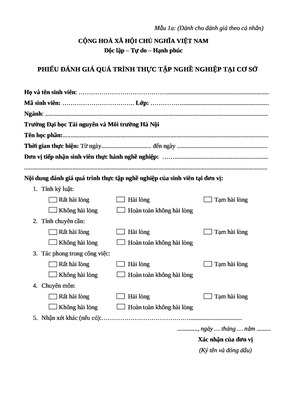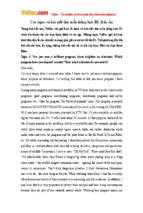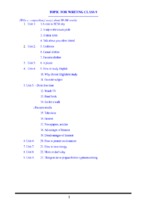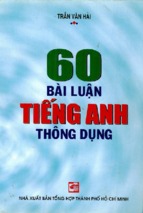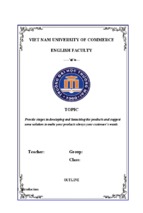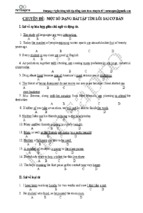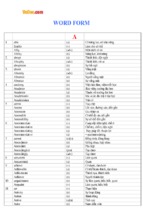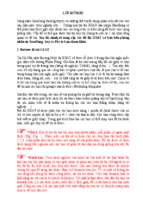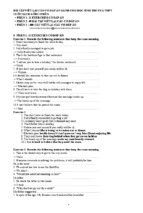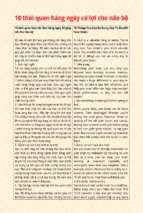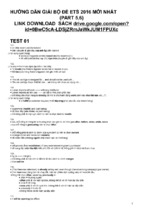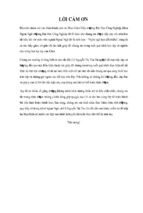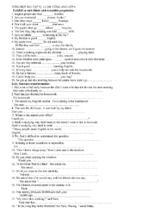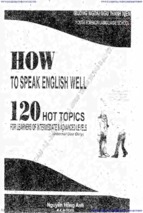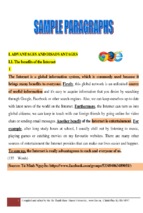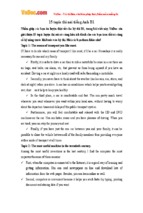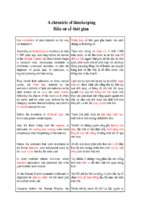VIETNAM NATIONAL UNIVERSITY – HO CHI MINH CITY
UNIVERSITY OF SOCIAL SCIENCES AND HUMANITIES
FACULTY OF ENGLISH LINGUISTICS AND LITERATURE
A SURVEY INTO THE TEACHING OF LEXICAL
COLLOCATIONS IN ACADEMIC WRITING AT
FACULTY OF ENGLISH LINGUISTICS AND
LITERATURE – UNIVERSITY OF SOCIAL
SCIENCES AND HUMANITIES – HO CHI MINH
CITY
A thesis submitted to the
Faculty of English Linguistics & Literature
in partial fulfillment of the Master‟s degree in TESOL
By
DANG THI VAN DI
Supervised by
NGUYEN THI KIEU THU, Ph.D.
HO CHI MINH CITY, AUGUST 2014
STATEMENT OF AUTHORSHIP
I hereby certify my authorship of the thesis submitted today entitled:
A SURVEY INTO THE TEACHING OF LEXICAL COLLOCATIONS IN
ACADEMIC WRITING AT FACULTY OF ENGLISH LINGUISTICS AND
LITERATURE, UNIVERSITY OF SOCIAL SCIENCES AND
HUMANITIES – HO CHI MINH CITY
in terms of the statement of Requirements for the Thesis in Master‟s Program
issued by the Higher Degree Committee. The thesis has not been submitted for the
award of any degree or diploma in any other situation.
Ho Chi Minh City, August 2014
Đặng Thị Vân Di
i
RETENTION AND USE OF THE THESIS
I hereby state that I, Đặng Thị Vân Di, being the candidate for the degree of
Master in TESOL, accept the requirements of the University relating to the
retention and use of Master‟s Theses deposited in the Library.
In terms of these conditions, I agree that the original of my thesis deposited in the
Library should be accessible for the purpose of study and research, in accordance
with the normal conditions established by the library for the care, loan or
reproduction of the thesis.
Ho Chi Minh City, August 2014
Đặng Thị Vân Di
ii
ACKNOWLEDGEMENTS
I owe a great debt of gratitude to those who have helped me complete this thesis.
First and foremost, I would like to express my gratefulness to my teacher and
supervisor, Dr. Nguyễn Thị Kiều Thu, for all her kindness, encouragement, and
valuable guidance. In this thesis process, her support and endless advice guided
and led me through times of difficulty.
I am greatly indebted to the Board of Administrators of the Faculty of English
Linguistics and Literature, whose facilitation and assistance greatly contributed to
the implementation of this thesis.
My sincere thanks also go to my colleagues at the Faculty, especially Ms. Lâm
Như Bảo Trân, Ms. Bùi Huỳnh Thủy Thương, Ms. Hồ Thị Thúy Kiều, Ms.
Nguyễn Thị Hằng and many others for their constant care, support, and willingness
to help and share experience.
This study would not have been completed without the affectionate consideration
from my close friends, Ms. Lê Hoàng Anh, Ms. Lê Thị Minh Hiếu, Ms. Trần Thị
Bích Ngọc, Ms. Lưu Nguyễn Hà Vy, and Ms. Nguyễn Phan Quỳnh Thơ. Their
care, support, encouragement, and understanding were sources of motivation for
my effort to complete the thesis.
Last but not least, my passionate love and heartfelt are extended to my late father,
my loving and caring mother, and my brother who nurtured my love for English
and teaching, strengthened my motivation, and gave me encouragement, especially
in times of trouble.
iii
TABLE OF CONTENTS
STATEMENT OF AUTHORSHIP ...................................................................................... i
RETENTION AND USE OF THE THESIS .......................................................................ii
ACKNOWLEDGEMENTS ................................................................................................iii
TABLE OF CONTENTS .................................................................................................... iv
LIST OF ABBREVIATIONS ............................................................................................vii
LIST OF TABLES ............................................................................................................viii
LIST OF FIGURES ............................................................................................................. x
ABSTRACT ........................................................................................................................ xi
CHAPTER 1
INTRODUCTION ..................................................................................... 1
1.1 BACKGROUND TO THE STUDY .......................................................................... 1
1.1.1 The Academic Writing Course ........................................................................... 1
1.1.2 The Lexical Approach......................................................................................... 2
1.1.3 Collocation .......................................................................................................... 3
1.2 AIM OF THE STUDY............................................................................................... 5
1.3 THE RESEARCH QUESTIONS ............................................................................... 6
1.4 SIGNIFICANCE OF THE STUDY........................................................................... 7
1.5 TERMINOLOGY ...................................................................................................... 7
1.6 SCOPE OF THE STUDY .......................................................................................... 8
1.7 ORGANIZATION OF THE STUDY ........................................................................ 8
CHAPTER 2
REVIEW OF LITERATURE ............................................................... 10
2.1 THEORETICAL ISSUES ON COLLOCATIONS ................................................. 10
2.1.1 Definition of Collocation .................................................................................. 10
2.1.2 Categorization of Collocations ......................................................................... 15
2.1.2.1 Grammatical Collocations ......................................................................... 16
2.1.2.2 Lexical Collocations .................................................................................. 16
2.2 COLLOCATIONS IN EFL...................................................................................... 18
2.2.1 The significance of Collocations in EFL .......................................................... 18
2.2.2 Collocations and Vocabulary Teaching ............................................................ 20
2.2.3 Collocations and Writing .................................................................................. 21
2.2.4 The Teaching of Collocations ........................................................................... 24
iv
2.2.4.1 How to Teach Collocations ........................................................................ 25
2.2.4.2 What Collocations to Teach ....................................................................... 30
2.2.4.3 Assessment of Collocational Competence ................................................. 31
2.2.5 Types of Collocational Errors ........................................................................... 32
2.2.6 Causes of Making Collocational Errors ............................................................ 33
2.3 ERROR ANALYSIS ............................................................................................... 36
2.4 THE CONCEPTUAL FRAMEWORK ................................................................... 38
2.5 SUMMARY ............................................................................................................. 41
CHAPTER 3
METHODOLOGY .................................................................................. 42
3.1 CONTEXT OF THE STUDY.................................................................................. 42
3.2 RESEARCH QUESTIONS ..................................................................................... 43
3.3 RESEARCH DESIGN ............................................................................................. 44
3.3.1 Participants ........................................................................................................ 44
3.3.1.1 Student Participants ................................................................................... 44
3.3.1.2 Teacher Participants ................................................................................... 46
3.3.2 Research Materials ............................................................................................ 48
3.3.2.1 Coursebooks ............................................................................................... 48
3.3.2.2 AW Final Writing Papers........................................................................... 49
3.3.2.4 COCA ........................................................................................................ 50
3.3.3 Research Instruments ........................................................................................ 53
3.3.3.1 Coursebook Analysis ................................................................................. 53
3.3.3.2 Error Analysis ............................................................................................ 54
3.3.3.3 Questionnaire ............................................................................................. 55
3.3.3.4 Interviews ................................................................................................... 60
3.4 DATA COLLECTION PROCEDURE.................................................................... 64
3.4.1 Lexical Collocational Error Identification ........................................................ 64
3.4.2 Questionnaire Administration ........................................................................... 68
3.4.3 Coursebook Analysis ........................................................................................ 68
3.4.4 Interview Conducting........................................................................................ 69
3.5 DATA ANALYSIS PROCEDURE ......................................................................... 70
3.5.1 Lexical Collocational Error Analysis................................................................ 70
3.5.2 Questionnaire .................................................................................................... 71
3.5.3 Coursebook Analysis ........................................................................................ 71
v
3.5.4 Interview ........................................................................................................... 71
3.6 SUMMARY ............................................................................................................. 71
CHAPTER 4
RESULTS AND DISCUSSION .............................................................. 72
4.1 DATA ANALYSIS AND DISCUSSION ............................................................... 72
4.1.1 The Teaching Practices of Lexical Collocations .............................................. 72
4.1.1.1 Coursebooks ............................................................................................... 72
4.1.1.2 Instructions of Lexical Collocations .......................................................... 73
4.1.1.3 Assessment ................................................................................................. 78
4.1.2 The Learning of Lexical Collocations .............................................................. 80
4.1.2.1 Students‟ Perception of Collocations ......................................................... 80
4.1.2.2 Types of Lexical Collocational Errors ....................................................... 85
4.1.2.3 Causes of Lexical Collocational Errors ..................................................... 88
4.1.3 Summary ........................................................................................................... 93
4.2 MAJOR FINDINGS ................................................................................................ 94
4.3 SUMMARY ............................................................................................................. 98
CHAPTER 5
CONCLUSION AND RECOMMENDATIONS ................................. 99
5.1 CONCLUSION ........................................................................................................ 99
5.2 RECOMMENDATIONS ....................................................................................... 100
5.2.1 Recommendations to Teachers ....................................................................... 101
5.2.2 Recommendations to Students ........................................................................ 105
5.2.3 Recommendations to EF Administrators ........................................................ 106
5.2.4 Recommendations for Future Research .......................................................... 106
REFERENCES ................................................................................................................ 108
APPENDIX 1: SYLLABUS FOR ACADEMIC WRITING........................................... 117
APPENDIX 2: FINAL TEST PAPER IN ACADEMIC WRITING ............................... 123
APPENDIX 3: QUESTIONNAIRE ................................................................................ 125
APPENDIX 4: INTERVIEW WITH AW STUDENTS .................................................. 127
APPENDIX 5: INTERVIEW WITH AW TEACHERS .................................................. 127
APPENDIX 6: SAMPLE AW FINAL TEST PAPERS .................................................. 128
vi
LIST OF ABBREVIATIONS
AW
Academic Writing
BNC
the British National Corpus
CA
Contrastive Analysis
CLT
Communicative Language Teaching
COCA
the Corpus of Contemporary American English
EA
Error Analysis
EF
the Faculty of English Linguistics and Literature
EFL
English as a Foreign Language
EGP
English for General Purposes
ELT
English Language Teaching
ESL
English as a Second Language
ESP
English for Specific Purposes
LA
the Lexical Approach
MI
Mutual Information
OCD
Oxford Collocations Dictionary for Students of English
USSH
the University of Social Sciences and Humanities – Ho Chi Minh City
vii
LIST OF TABLES
Table 2.1: Eight Types of Grammatical Collocations ............................................16
Table 2.2: Seven Categories of Lexical Collocations .............................................17
Table 2.3: The Revised Six Categories of Lexical Collocations ............................17
Table 2.4: Sources of Collocational Errors .............................................................35
Table 3.1: Sampling of AW Teachers.....................................................................47
Table 3.2: The Coding of Five AW Teachers .........................................................47
Table 3.3: A comparison between COCA and other Corpora (by Davies (2008)) .50
Table 3.4: A comparison of collocates between COCA and BNC (Oxford
University Press, 1998) ...........................................................................................51
Table 3.5: The Procedure of EA (adopted from Gass and Selinker (2008)) ..........55
Table 3.6: The Function of Questionnaire Items ....................................................59
Table 3.7: The Function of Questions in the Interview ..........................................62
Table 3.8: Synthesis of Research Instruments and their Functions ........................63
Table 3.9: The Identification of Headwords in Lexical Collocations.....................65
Table 3.10: A Record of Coursebook Content........................................................68
Table 4.1: Students‟ Statement of the Classroom Instruction of Lexical
Collocations in AW .................................................................................................74
Table 4.2: Teaching Strategies of Lexical Collocations .........................................76
Table 4.3: AW Teachers‟ Criteria of Good Pieces of Writing ............................... 79
Table 4.4: AW Students‟ Understanding of the Term „Collocation‟ ......................81
Table 4.5: AW Students‟ Receptive Knowledge of Lexical Collocations .............82
Table 4.6: Sources of AW Students‟ Collocational Knowledge ............................83
Table 4.7: AW Students‟ Opinions about the Role of Collocations .......................83
viii
Table 4.8: Lexical Combinations Produced by AW Students ................................ 85
Table 4.9: AW Students‟ Errors in Lexical Collocations .......................................86
Table 4.10: Summary of Sources of Lexical Collocational Errors Made by AW
Students ...................................................................................................................92
Table 4.11: Summary of the Results .......................................................................93
ix
LIST OF FIGURES
Figure 2.1: Synthesis of Issues Related to the Teaching of Lexical Collocations in
Academic Writing ...................................................................................................40
Figure 3.1: The COCA Search Interface.................................................................66
Figure 3.2: Sample COCA Search Result ............................................................... 67
Figure 3.3: The Summarization of the Data Collection Procedure.........................70
x
ABSTRACT
Collocation nowadays has been acknowledged as a requisite in EFL and has
gained considerable attention from both researchers and teachers. However, little
research has been conducted on the teaching of lexical collocations in a writing
course to English majors, especially in the context of EFL in Vietnam. In addition,
errors in collocations have always been found in learners‟ written production of
language. The current study, therefore, aimed at investigating the current teaching
of lexical collocations in Academic Writing at EF, USSH in terms of two aspects:
(1) classroom teaching practices (coursebook contents, classroom instructions, and
course assessment criteria) and (2) the learning situation among AW students
(perception of collocations, types of errors, and causes of errors). Four instruments
– error analysis, coursebook analysis, questionnaire, and interview – were devised
in order to acquire data to understand the teaching of lexical collocations.
Findings of the study indicated that the teaching practices of lexical collocations in
AW were limited, together with a lack of focus on lexical collocations in
coursebook contents and assessment criteria. Furthermore, the current situation of
learning lexical collocations in AW was not positive through students‟ unclear
perception of the issue, and a number of errors categorized into six types – in
which verb-noun combinations were the key contributor. It was also revealed that
the negative influence of their first language and approximation were the major
causes of these errors. Recommendations were thus formulated to integrate the
teaching and learning of lexical collocations into AW and other language skills
courses at EF, to provide training to teachers, and to implement future studies on
the issue.
xi
CHAPTER 1
INTRODUCTION
This chapter provides the introduction to the study. The chapter includes (1)
background to the study, (2) aim of the study, (3) research questions, (4)
significance of the study, (5) terminology, (6) scope of the study, and (7) the
overall structure of the study.
1.1 BACKGROUND TO THE STUDY
1.1.1 The Academic Writing Course
Since the credit-based system was adopted in Faculty of English Linguistics and
Literature (EF), University of Social Sciences and Humanities (USSH) in 2006,
there have been changes implemented to the curriculum of the Faculty. New
courses with new requirements were designed so as to meet the increasing
demands in the teaching and learning of English as a Foreign Language (EFL).
One of the new courses is Academic Writing (AW). The course is required for all
English majors, which is taken after the students have successfully passed
fundamental language skills courses in the very first semesters. AW takes up four
credits, which is equivalent to 60 periods or twelve 5-period class meetings. Seen
as an intermediate course prior to students‟ selection of their own specialization,
the course aims at enhancing students‟ writing skills for academic purposes.
Staged at an advanced level, the course prepares the students for upcoming courses
with more demanding requirements, particularly those which require a high
amount of academic writing.
Focusing on English writing for academic purposes, the course entails various
skills and genres. The students learn how to write topic sentences and thesis
statements, outline and organize their paragraphs and essays, connect the ideas and
parts of the piece of writing, and write different kinds of paragraphs and essays.
The two coursebooks Reason to write – Strategies for success in academic writing
by Cohen and Miller (2003), and Writing academic English by Oshima and Hogue
(1991) clearly highlight writing skills and mechanics.
1
The students‟ performance is evaluated based on their written production during
and at the end of the course. One midterm test (of which results account for 30
percent of the students‟ total scores) and one final test (70 percent) are obligatory,
together with writing assignments throughout the course. The midterm and final
test papers usually comprise two parts: one on theories involved with academic
writing, and the other with paragraph or mostly essay writing (for further details of
the course, see Appendix 1). In other words, the students, throughout the course,
are required to write a number of compositions which show both their writing and
language skills.
1.1.2 The Lexical Approach
There have been quite a number of approaches to language teaching, each of which
has its own focus and requisite. The most popular approaches in English Language
Teaching (ELT) nowadays could be counted as the Communicative Language
Teaching (CLT) and Task-Based Learning. In addition, an alternate approach to
language teaching has been developed: the Lexical Approach.
The Lexical Approach (LA) was first described by Michael Lewis in 1993. It is a
new approach in ELT built from the belief that the most important aspect of
language learning and teaching should be vocabulary, not grammar or structures,
like what some previous methods (such as the grammar-translation method) hold.
To put it differently, the approach highlights grammaticalized lexis rather than
lexicalized grammar. The core of LA is collocation, which is usually apprehended
as the regular co-occurrence of words in a language. This is believed to play an
important part in language learning and communication. There used to be quite a
number of objections to LA during the time it was first introduced. However, the
approach has found its way to EFL classrooms over time and has proved itself
effective in language teaching and learning (Lewis, 2000a).
In spite of the increasing popularity of LA, the communicative language teaching
(CLT) is still having a predominant role, which focuses on learners‟ interactions in
order to achieve communicative proficiency and fluency. Despite such a fact, the
2
two approaches have at least one thing in common: the heart of the two approaches
is communication and learners‟ competence to communicate fluently, because LA
also “places communication of meaning at the heart of language and language
learning” (ibid., p. 15).
Even though the two approaches are more or less alike in their focus, it appears
that CLT does not lay its emphasis on prefabricated chunks. There is a belief, in
LA, that lexical words and phrases are “main carriers of meanings”, and that
learning words and phrases also brings together all the elements that used to be
separately treated – grammar, vocabulary, and pronunciation (ibid.). Such a
combination will greatly assist learners in turning the language to which they are
exposed to what they can apply in communication.
In the context of Vietnam in general and EF in particular, the approach is still new
and thus hardly followed by teachers of English. More specifically, English
prefabricated chunks are rarely taught by teachers, partially for most of the
classroom time is spent on the practice of English language skills – reading,
writing, listening, and speaking. Also, it could be said that teachers are not fully
aware of the importance of lexis in language learning, which is one of the motives
that drove the researcher to carry out this study.
1.1.3 Collocation
Since the description of LA in the 1990s, researchers‟ and teachers‟ viewpoints on
vocabulary teaching and learning have been changed: the focus of learning and
teaching once on grammatical structures was shifted to vocabulary. However, the
focus is not merely turned on individual words, but on the combinations of words
in language use. That is to say, an important part of language learning is the ability
of proper use of lexical phrases, or chunks. One type of these lexical chunks is
collocation, for example word combinations like bitter criticism, or rekindle
friendship, etc., which is regarded as the core of LA.
3
Collocation, in effect, has become one of the major concerns in the field of foreign
language teaching and learning. To be more specific, collocation is a common
phenomenon in the English language and its significance in EFL has also been
recognized. Brown (1974), Bahns and Eldaw (1994), Lewis (1993), Farghal and
Obiedat (1995), and Howarth (1998) were apparently the first researchers to have
investigated the increasing requisite of collocation in English teaching and
learning. All of these researchers agreed upon the role of collocation as promoting
learners‟ language competence, especially in vocabulary, and their communicative
competence. Also, collocation is regarded as a criterion to distinguish native
speakers from non-native ones (Schmitt, 2000; Nation, 2001; Brashi, 2006;
Nesselhauf, 2005; Bazzaz & Samad, 2011). These studies arrived at the conclusion
that the knowledge of collocation is absolutely necessary to EFL learners and that
the teaching of collocation should be promoted in EFL courses.
However, it is a proven fact that EFL learners have often made a huge number of
errors in collocation in their production of written and spoken English due to the
lack of collocational knowledge (Bahns and Eldaw, 1994; Farghal and Obiedat,
1995; Brashi, 2006; Hsu, 2007; Huang, 2001; Li, 2005; Parastuti, 2005; Sun &
Shang, 2010; Darvishi, 2011). Some errors like *1expensive price or to *learn
knowledge are usually identified in EFL learners‟ written and spoken production. It
is to say that attention has not been directed to collocation, and that it has not been
properly and effectively integrated into EFL teaching. As a matter of fact, the
aforementioned researchers have suggested that teachers should improve their
learners‟ knowledge of collocations2, firstly by raising their awareness of
collocations through the identification and correction of collocational errors,
introduction of some collocations, etc.
1
The use of an asterisk (*) henceforth is an indication of a collocational error.
The single form of the word “collocation” refers to the general phenomenon in which
words collocate with each other, while the plural form indicates individual cases of
collocation.
2
4
It is an observable fact that the students at EF, especially those who regularly have
to submit their written exercises and assignments, frequently commit errors in
collocation. The production of collocations in writing seems to be more difficult
and challenging, for precision in word use is a must in written contexts (Tran, T.
H., 2012), where one has more time to think about and polish their language use.
Also, according to Nesselhauf (2003), students of high levels of English
competence, in particular, are more likely to make errors in (lexical) collocations,
for they tend to apply a larger and usually more complex amount of vocabulary to
their language production. It seems that the students can quite well manage very
common combinations like do exercise, make a cake, etc. but they often
experience difficulty in most other collocations, such as *meet a problem, *wide
knowledge, (instead of have/face a problem, vast knowledge respectively) and the
like. These errors result in not only the students‟ level of proficiency but also their
mastery of the language.
Even though many researchers have conducted studies investigating the use of
collocations among EFL learners, little research has been undertaken into the
teaching of (lexical) collocations in a writing course to English majors. In other
words, instructors‟ classroom teaching practices as well as students‟ learning of the
issue have not been explored. Even in the context of EFL in Vietnam, only two
studies on collocations have been found: one experimental study on the effects of
collocation instruction on students‟ writing scores, the other on the teaching of
ESL conversations through collocations. This was identified as the research gap,
alongside the current situation, that drove the researcher to conduct the present
study to examine the teaching of lexical collocations in AW at EF, USSH.
1.2 AIM OF THE STUDY
The fact remains that there are many errors in collocations, especially those in
lexical collocations, found among EF students‟ English writings. This addresses a
question as to why they have made such errors in their writing products. In order to
have a comprehensive and detailed look into the phenomenon and its possible
5
causes, the current study was conducted. The study was carried out in AW because
this is among the courses that require students to frequently produce written work
and involve students with a degree of high competence in English. Together with
the aforesaid research gap identified in the field, there is a need that the study
should be conducted, given the theoretical underpinnings as well as the
contemporary pedagogical practice. To put it differently, the aim of the study was
to explore the teaching of lexical collocations in the course of AW taken by
English sophomores at EF, USSH. This aim could only be fulfilled by
investigating the teaching practices and learning situation of lexical collocations in
the course.
1.3 THE RESEARCH QUESTIONS
Despite its increasingly significant role in these decades, collocation has hardly
been integrated into language teaching, especially in writing courses. There is
scarcely any extensive research into collocations, especially lexical collocations at
EF, USSH. Also, as above mentioned, there can only be found few studies
conducted on the teaching of collocations in writing courses for English majors.
Endorsed by the accumulated teaching experiences in previous writing courses, the
researcher believed that the teaching of lexical collocations in AW would be not
only practical but necessary and beneficial to students as well. It helps build the
massive amounts of language input among learners, from which they can turn into
intake to achieve fluency in communication (Lewis, 2000a).
The two aforementioned issues led the researcher to generate the following
research questions in order to accomplish the earlier stated aim:
(1) What are the current teaching practices of lexical collocations in AW?
(2) What is the current situation of the learning of lexical collocations in AW?
6
1.4 SIGNIFICANCE OF THE STUDY
With such an aim fulfilled by answering such a research question, the study gained
significance in some following aspects.
Firstly, the study, to some extent, had theoretical values. The study provided a
thorough review of literature on theoretical issues as well as pedagogical
justifications of collocations and collocations teaching in language skills
classrooms. Also, the research uncovered the fact about the practical teaching of
lexical collocations in AW at EF, USSH. Furthermore, its findings revealed the
AW students‟ knowledge of collocation and the lexical collocational errors they
made in AW final test papers.
Secondly, the study made some contributions to the teaching of AW. The findings,
specifically, presented some recommendations for both the teaching and learning
of lexical collocations in AW so as to help students avoid committing errors in
lexical collocations. Also, grounded on the pivotal role of collocation itself, the
teaching of collocation should be promoted in other language skills courses.
1.5 TERMINOLOGY
The key terms used in the present study will be discussed in this part for the sake
of clarity throughout the study. The study was conducted with a central focus on
lexical collocations, one of the cores of LA. According to Richards and Schmidt
(2002), LA is “an approach to language teaching that is based on the view that the
basic building blocks of teaching and learning are words and lexical phrases, rather
than grammar, functions or other units of organization” (p. 304), or simply a
“lexis-based approach to language teaching”, as Richards and Rodgers (2001)
named it (p. 138). Collocation, then, is referred to as “a combination of words in a
language, that happens very often and more frequently than would happen by
chance” by Oxford Advanced Learners‟ Dictionary (a further and more detailed
explanation of the term will be presented in the next chapter, the review of related
literature).
7
In addition to those major terms, there were also scattered a number of other
technical terms used in the study as follows:
-
Delexicalized words: words that still carry some definite meaning even out
of context (Lewis, 2000a)
-
Corpus: a collection of (both spoken and written) texts (Lewis, 2000a)
-
Concordancer: “software that searches for words of phrases in a corpus and
displays the selected item or items in a list together with their surrounding
context” (Richards & Schmidt, 2002, p. 104)
1.6 SCOPE OF THE STUDY
The study was confined to exploring the practical teaching of lexical collocations
in AW, which ran in the second semester of academic year 2012-2013 at EF,
USSH. It focused on exploring the teaching practices of lexical collocations in the
course of AW and qualitatively analyzing the lexical collocational errors made by
the students. The sampling strategy, as well as the specific research site, resulted in
the weak generalizability of the study. Due to the nature of the research and
sampling strategy, and based on the findings of the study, generalizations and
recommendations were made to the teaching and learning in AW and other
language skill courses at EF, USSH. The study findings would be seen as
qualitative descriptions of the existing situation, and therefore would provide
theoretical and practical background and tentative suggestions for further research.
1.7 ORGANIZATION OF THE STUDY
This study report comprises five separate chapters.
Chapter 1 provides the introduction with background information of the study.
Chapter 2 presents a review of relevant and previous literature on collocations and
collocations in EFL. A detailed review of theoretical issues on collocations, in
terms of definition and categorization, is provided. Then the background of the
important role of collocations, collocations in relation with vocabulary and writing,
8
- Xem thêm -

